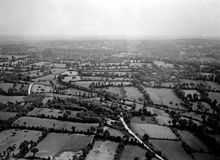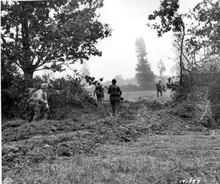Rhino tank
| Rhino tank | |
|---|---|
|
An M4 Sherman-based United States Rhino tank crashes through a hedgerow. | |
| Service history | |
| In service | 1944 |
| Used by | Canada, United Kingdom, United States |
| Wars | World War II |
| Production history | |
| Designer | Various, but generally credited to Curtis G. Culin |
| Designed | 1944 |
The Rhino tank (initially called "Rhinoceros")[1] was the American nickname for Allied tanks fitted with "tusks", or hedgerow cutting devices, during World War II. The British designation for the modifications was Prongs.
In the summer of 1944, during the Battle of Normandy, Allied forces – particularly the Americans – had bogged down fighting the Germans in the Normandy bocage. This landscape of thick banked hedges proved difficult for tanks to breach. In an effort to restore battlefield mobility, various devices were invented to allow tanks to navigate the terrain. Initially the devices were manufactured in Normandy, largely from German steel-beam beach defensive devices on an ad hoc basis. Manufacture was then shifted to the United Kingdom, and vehicles were modified before being shipped to France.
While the devices have been credited with restoring battlefield mobility in the difficult terrain historians have questioned their overall usefulness and tactical significance.
Background

Following the Normandy landings of June 1944, as Allied forces pushed inland from the French coast, they found themselves operating within an area of Normandy's countryside known as the bocage. The actual bocage landscape extends further than the limited definition of bocage normand, that is to say, from the area directly west of Arromanches-les-Bains, including the entire Cotentin Peninsula, to the south of Brittany, Maine, and Vendée. In some areas, this terrain stretches for 50 miles (80 kilometres).[2][3] This landscape contained large earth dikes averaging 4 ft (1.2 m) high that were covered with tangled hedges, bushes, and trees that surrounded small raised irregular-sized fields, which were generally no more than 300 ft (91 m) across.[4][2] The nature of the hedgerows—"sturdy embankments, half earth, half hedge"[5] up to 15 ft (4.6 m) high with interlocking root systems—made excavating them extremely difficult, even with machinery.[6] Narrow sunken tracks were the only pathways between these banks. Tank movement was severely restricted, preventing the Allied forces from bringing their vehicle superiority to bear,[2] and making aerial observation with light aircraft like the Piper L-4 Grasshopper[7] and Auster AOP important in spotting German tank destroyers and anti-tank cannon emplacements concealed within the enclosed patches of land a distinct priority. The rolling landscape was also dotted with small rivers, woods, and fruit trees, along with scattered stone farmhouses and their outbuildings.[8]
Allied infantry, in particular the Americans, found themselves fighting from field to field against the Germans, who were positioned in prepared defensive positions housing machine gun and rifle emplacements. The Germans had in many places cut foxholes and other defensive structures directly into the hedgerows and embankments. These defensive positions limited the ability of the American forces to coordinate large-scale attacks or receive sufficient and accurate artillery support.[4] Openings that did exist within the patchwork of hedges were already covered by German anti-tank weapons; armor moving through these gaps attracted immediate defensive fire. Tanks were able to run over the banks—but in doing so they would expose their weak underside armor. Tactical developments throughout June involved combat engineers blowing holes in the hedgerow walls for tanks to move through; however, the explosions attracted German attention to the American positions.[9]
Invention
Prior to the launch of Operation Cobra (an American offensive during the Normandy campaign), solutions were developed for how tanks could effectively support the offensive within this terrain.[10] Bulldozers or tanks modified to carry a bulldozer blade were used to open gaps in hedgerows. Some hedgerows were so thick that engineers first had to blow a hole in the bank, which a bulldozer would later clear and widen. This time-consuming process slowed down the progress of the Allied offensive.[11] Throughout July "innumerable" inventions were created by various American units to get tanks through the hedges quickly without exposing their weak underside armor. A hedgecutter developed by the 79th Infantry Division was in operation by 5 July, and a few days later, XIX Corps demonstrated a set of prongs that had been initially developed to create holes for the placement of explosives. These prongs were able to lift and remove a portion of the vegetation, enough so that the tank would be able to crash through to the other side. Units within V Corps also invented devices, which were dubbed 'brush cutters' and 'greendozers'.[12]

The invention of a hedge-breaching device is generally credited to Curtis G. Culin, a sergeant in the 2nd Armored Division's 102nd Cavalry Reconnaissance Squadron. However, military historian Max Hastings notes that Culin was inspired by "a Tennessee hillbilly named Roberts",[6] who during a discussion about how to overcome the bocage, said "Why don't we get some saw teeth and put them on the front of the tank and cut through these hedges?" Rather than joining in the laughter that greeted this remark, Culin recognized the idea's potential.[6] A prototype tusk-like assembly was created by welding steel scrap (from destroyed "Czech hedgehogs") to the front of a tank to create a hedge cutter. The teeth helped prevent the vulnerable underside of the tank from being exposed while it knocked a hole in the hedgerow wall.[12][6] On 14 July, Lieutenant General Omar Bradley inspected the tank[12] and "watched in awe as a hedgerow exploded ... to make way for the Sherman bursting through".[6] According to Hastings, Culin, "an honest man", attempted to give credit to Roberts, but this was forgotten in the publicity surrounding the invention. Hastings concludes: "[Culin] became a very American kind of national hero".[6]
The American official campaign historian, Martin Blumenson, notes that Bradley, impressed, ordered the device be manufactured in quantity. Initially this was done using steel salvaged from the thousands of obstacles, such as Czech hedgehogs, that the Germans had placed on the French beaches during the construction of the Atlantic Wall. Bradley also dispatched Colonel John Medaris (of the Ordnance Corps) back to the United Kingdom to have tanks modified before being shipped to France, and arranged for additional arc welding equipment and crews to be transported to France by air.[12][13]
Around 500 of the assemblies, called the "Culin Rhino device" or "Culin hedgerow cutter" by the Americans, were manufactured. These devices were used to modify nearly three-quarters of the US 2nd Armored Division's M4 Sherman and Stuart tanks and M10 tank destroyers in preparation for Operation Cobra.[13][lower-alpha 1] The British Royal Electrical and Mechanical Engineers (REME) referred to the devices as "Prongs" and produced 24 from ex-German beach defenses, but thereafter Prongs were produced in the United Kingdom. Six hundred Mark I Prongs were delivered by August, to be fitted to the Sherman V. A further 1,000 Mark II Prongs were produced, to be fitted on Shermans and the M10, and 500 Mark III prongs were manufactured for the Cromwell tank. The Churchill tanks were not considered to need the Prong, but some were equipped with them nonetheless.[14]
Usage

War correspondent Chester Wilmot wrote after the war that the German defensive plan to halt any American breakout was to hold the front line "very lightly and to concentrate upon holding the road junctions for a depth of three or four miles behind the front", with the intention of delaying any break-through by reducing the speed of the advance to the pace the infantry could manage.[15] Once Operation Cobra was launched, Allied troops were able to bypass the German positions using the Rhino tanks, thereby allowing the advance to continue, leaving the strong points to be dealt with by infantry and engineers.[16]
Blumenson describes how during the launch of Operation Cobra, tanks with the 2nd Infantry Division, supported by artillery, advanced without infantry for twenty minutes, covering several hundred yards and knocking holes in hedgerows before returning to their starting position. The tanks and infantry then advanced rapidly together before the Germans were able to re-establish their defensive positions.[17]
During Operation Bluecoat (a British offensive during the Normandy campaign), British Churchill tanks[lower-alpha 2] equipped with Prongs were able to traverse terrain considered impassable to tracked vehicles, taking the German defenders by surprise.[18]
Military historian Steven Zaloga claims that the devices "were not as widely used as the legend would suggest", nor were they as effective as is often believed.[13] But Max Hastings and Chester Wilmot credit the invention with restoring battlefield maneuverability to the Allied force.[6][19] Martin Blumenson states that while the device restored mobility in hedgerow country, it "was of little tactical value in the breakout, except possibly as a morale factor to the troops, since the tanks advanced on the roads, not cross-country."[20]
See also
Notes
Footnotes
- ↑ The US official campaign historian states that by the time Operation Cobra was launched, "three out of every five tanks in the First Army mounted the hedgecutter".[1]
- ↑ These tanks were of the 6th Guards Tank Brigade.
Citations
- ↑ 1.0 1.1 Blumenson 2005, p. 207.
- ↑ 2.0 2.1 2.2 Reynolds 2001, p. 50-51.
- ↑ Harrison 2002, p. 180.
- ↑ 4.0 4.1 Harrison 2002, p. 284.
- ↑ Doubler 1988, p. Chapter 1: The Operational Setting.
- ↑ 6.0 6.1 6.2 6.3 6.4 6.5 6.6 Hastings 1999, p. 296.
- ↑ Fountain, Paul (1945). "The Maytag Messerschmitts". Flying Magazine (March 1945): 90.
- ↑ Buckley 2006, p. 9.
- ↑ Blumenson 2005, p. 41-42.
- ↑ Blumenson 2005, p. 205.
- ↑ Blumenson 2005, p. 205-206.
- ↑ 12.0 12.1 12.2 12.3 Blumenson 2005, p. 206.
- ↑ 13.0 13.1 13.2 Zaloga 2001, p. 46.
- ↑ Fletcher 1993, p. 98-99.
- ↑ Wilmot & McDevitt 1997, p. 390.
- ↑ Wilmot & McDevitt 1997, p. 393.
- ↑ Blumenson 2005, p. 284.
- ↑ Buckley 2006, p. 144.
- ↑ Wilmot & McDevitt 1997, p. 392.
- ↑ Blumenson 2005, p. 332.
References
- Blumenson, Martin (2005) [1951]. Breakout and Pursuit. United States Army in World War II: The European Theatre of Operations. Washington DC: Center of Military History, United States Army. OCLC 1253744. ASIN: B00313IYQ0
- Buckley, John (2006) [2004]. British Armour in the Normandy Campaign 1944. London: Taylor & Francis. ISBN 0-415-40773-7. OCLC 154699922.
- Doubler, Captain Michael D. (1988) [1955]. Busting the Bocage: American Combined Arms Operations in France June—31 July 1944. Combat Studies Institute. Retrieved 15 March 2012.
- Fletcher, David (1993). The Universal Tank: British Armour in the Second World War Part 2. London: Her Majesty's Stationery Office. ISBN 978-0-11-290534-9.
- Harrison, Gordon A (2002) [1951]. Cross-Channel Attack. United States Army in World War II. Washington DC: Center of Military History, United States Army. ISBN 978-1-4102-0163-8. Library of Congress Catalog Card Number: 51–61669
- Hastings, Max (1999) [1984]. Overlord: D-Day and the Battle for Normandy 1944. Pan Grand Strategy Series. London: Pan Books. ISBN 0-330-39012-0.
- Reynolds, Michael (2001) [1997]. Steel Inferno: I SS Panzer Corps in Normandy. Da Capo Press. ISBN 1-885119-44-5.
- Wilmot, Chester; McDevitt, Christopher Daniel (1997) [1952]. The Struggle For Europe. Ware, Hertfordshire: Wordsworth Editions Ltd. ISBN 1-85326-677-9. OCLC 39697844.
- Zaloga, Steven J. (2001). Operation Cobra 1944: Breakout from Normandy. Oxford: Osprey. ISBN 1-84176-296-2.
External links
- Belmont, Larry (2001). "The World War II Photo of the Week for 20 August 2001: Hell in the Hedgerows ...". Retrieved 15 March 2012.
- Mehl, Captain Thomas W. (2009). "Guard NCO Invents Rhino Tank Plow". Army National Guard. Retrieved 15 March 2012.
- "Cromwell Prong". Photo Gallery of WW2. Retrieved 15 March 2012.